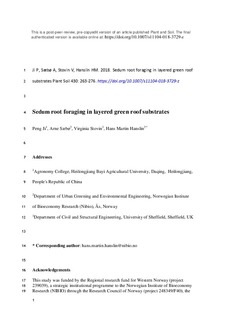Sedum root foraging in layered green roof substrates
Journal article, Peer reviewed
Accepted version
Permanent lenke
http://hdl.handle.net/11250/2593655Utgivelsesdato
2018-06-29Metadata
Vis full innførselSamlinger
Sammendrag
Background and aims Layered profiles of designed soils may provide long-term benefits for green roofs, provided the vegetation can exploit resources in the different layers. We aimed to quantify Sedum root foraging for water and nutrients in designed soils of different texture and layering. Methods In a controlled pot experiment we quantified the root foraging ability of the species Sedum album (L.) and S. rupestre (L.) in response to substrate structure (fine, coarse, layered or mixed), vertical fertiliser placement (top or bottom half of pot) and watering (5, 10 or 20 mm week−1 ). Results Water availability was the main driver of plant growth, followed by substrate structure, while fertiliser placement only had marginal effects on plant growth. Root foraging ability was low to moderate, as also reflected in the low proportion of biomass allocated to roots (5–13%). Increased watering reduced the proportion of root length and root biomass in deeper layers. Conclusions Both S. album and S. rupestre had a low ability to exploit water and nutrients by precise root foraging in substrates of different texture and layering. Allocation of biomass to roots was low and showed limited flexibility even under water-deficient conditions. Sedum root foraging in layered green roof substrates
